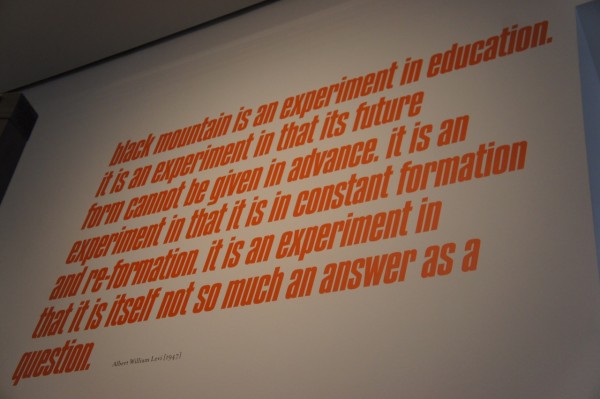Innovation in education
Searching for what works
* Photo from the exhibition “Black Mountain. An Interdisciplinary Experiment 1933 – 1957” open until 27.09.2015 at Hamburger Bahnhof – Museum für Gegenwart – Berlin
The field of education is attacked quite strongly today and with a big note: the times are changing and education needs to change as well. We need innovation. “OMG”, says teacher in the classroom or principal tired of a next change initiative. So, is there a way to learn to be wise in bringing change or innovation in the field that we care about? Because learning and education is something many of us deeply care for. We sense more and more that a different future is possible as Seth Godin says in “Learning Reimagined”: “Oh, let’s reinvent ourselves so that we can create better graduates for a different kind of world”.
The time of big questions
There are many initiatives around the world that tackle the issue of innovation in education (f.e. WISE), there are many schools, programmes, universities emerging all over the world that have decided to do things differently. At the core of those changes is the willingness to ask some of the big questions. Keri Facer, author of “Learning Futures” invites us to reflect on the following fundamental questions: what education is for? what does it take to live well in the world? what is it that we are going to need? how do we create meaningful ways of learning and living that combines multiple ways of being? how do we create a world where the point of life is life?
These questions invite us to question the most fundamental assumptions on the purpose of education. And these questions could be a source of ongoing conversation among experts, parents, students, community. What are the questions you need to ask from your colleagues and students? And how can we turn the answers into shaping more meaningful learning opportunities for all?
Messy innovation
All learning and education takes place in social context. So what are “our” contexts? And what do they speak of to us today? What do we notice, sense, experience today? And what does it tell about the future of learning?
Innovation is an ability to shape bold ideas into action. “Innovation is not an efficient process - it’s messy” says Zaid Hassan in his book “The Social Labs Revolution”. What is innovation in one context may not be so in another. Innovation arises from a community of people focused on trying out lots of things and learning their way to successful innovation. It means asking deeply how badly do we want it. Everything flows from commitment to play (Zaid Hassan). So, are we as educators committed to play in the field of the unknown? As the road is less travelled, some approaches might be helpful, f.e. social labs approach, U-theory or design thinking. These approaches entail some form of structure helping to navigate around the messy process of innovation.
Practice of innovation
Innovation is a form of art that is practiced constantly. Every educators should develop a capacity to be curious, do something without a map, dear to take risks. It entails the questioning mind: what is needed now to make learning meaningful? Innovation is not one time effort, but a constant search for what works. It is a practice where you set on a journey and build the road by walking. At the same time you stay flexible and responsive to any changes on the way.
As part of 1,5-year learning programme MoveMakers went to sensing journey in Netherlands, visiting quite diverse initiatives to understand innovation (f.e. bAmsterdam, Handshake, Team Academy, Knowmads, Freedom Lab etc). Some of the things we heard and saw were:
- making mistakes is part of learning. Therefore we could cultivate the spirit of experimentation in all learners.
- self-organisation and taking responsibility of one’s own learning. In Knowmads School 50 % of the learning is selforganised. It is important to support taking responsibility of one’s own learning starting from an early age.
- space matters. Materials, technology, space, tools help to take a handson approach to learning thus helping to make ideas instantly visible to others.
- learning takes place in cooperation and teams. Teamlearning approach could be used to help to solve some of the challenges of current life.
- learning in real life and from real life. Shaping tasks that are relevant and meaningful for the learners. At TeamAcademy learning is shaped around developing your own business.
- the “teacher” is a facilitator. Facilitator gives just enough guidance, supports reflection, and knows how to take care of him/herself.
While reading these few insights one may wonder, so what makes it all innovative? This is what learning should be about? Always. It seems that some programmes or initiatives have decided to address learning in holistic way, they just do what needs to be done. They are able to create before it is too late. They don’t wait for trends, but create those themselves. They ask constantly “What is the kind of place, where I would like to learn? “ and then create these places.So, the real creative challenge of our age starts now: to be the designer of education and meaningful learning every single day. It is about doing something that matters to us and dearing to say “this might not work” (Seth Godin). So shaping future learning is about welcoming creativity, experimentation and constant failing among all educators.
Piret Jeedas
MoveMakers



